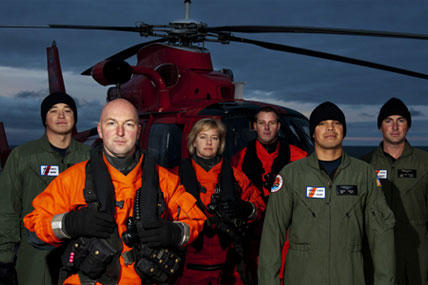It takes a great amount of teamwork to complete Coast Guard missions. Forward deployed assets like the Coast Guard Cutter Bertholf, a national security cutter, cooperate with other Coast Guard units while underway to execute the Coast Guard’s 11 statutory missions. One type of unit that supports the ship is the onboard aviation detachment.
Bertholf often sails with a deployed Coast Guard helicopter and crew, called the aviation detachment. The AVDET is under the direction of the senior pilot, an aircraft commander. The helicopters, most often MH-65 Dolphin helicopters, are used to augment or extend the range and capabilities of Bertholf’s sensors. The helicopter crews can operate covertly in total darkness, closely monitoring suspect vessels on the water or as long range reconnaissance to detect things like the ice edge in the Arctic.
AVDET ratings include aviation electronics technicians and aviation maintenance technicians, and when deployed from Coast Guard Helicopter Interdiction Tactical Squadron, they can operate as an aviation gunner. Although air stations have aviation survival technicians, they do not normally deploy to cutters.
During Operation Arctic Shield, an aviation detachment from Air Station Los Angeles sailed with the Bertholf for an Arctic domain awareness patrol that would test the capabilities of the Coast Guard in a region the new NSCs have not operated in before as well as help build partnerships with local communities on the northern slope of Alaska.
The AVDET is involved with numerous, varied cutter missions including ice reconnaissance, supply and personnel transfers, vessel identifications, marine mammal identification and aerial photography. In addition, the helicopter crew patrolled the maritime boundary for the United States.
It’s an exciting and rare opportunity to support the Bertholf as the first NSC operating in the Arctic’s challenging environment,” said Lt. Shelly Colbert, a pilot with the air crew. “We are helping to set the standard for future operations as the U.S. strives to increase its maritime domain awareness here.”
“Air transport is making outreach with the remote villages possible due to inaccessibility by other means. We are enabling the dialogue needed to establish partnerships with the local and native populations,” said Colbert. “This interaction will help determine how we can have the least impact on the environment and their subsistence while protecting natural resources and expanding global interests in this region,” she said.
The AVDET wasn’t without its own challenges, especially in such a remote place. After an inspection revealed a damaged Gimbal safety pin, a replacement part was flown in and changed in order for the helicopter to remain fully mission capable. A HC-130 Hercules airplane from Air Station Kodiak, Alaska, airdropped the part to the ship while underway. Within hours, the helicopter was once again operational.
Weather is often treacherous in the Arctic and definitely ever-changing. Traversing the helicopter to and from the flight hangar to the flight deck is challenging. However, the well-trained helicopter crew is always on standby for whatever mission is needed, including a possible search and rescue case.
Through teamwork and cooperation, multiple Coast Guard assets have been brought to bear in a challenging new environment to complete the missions of the Coast Guard.





























